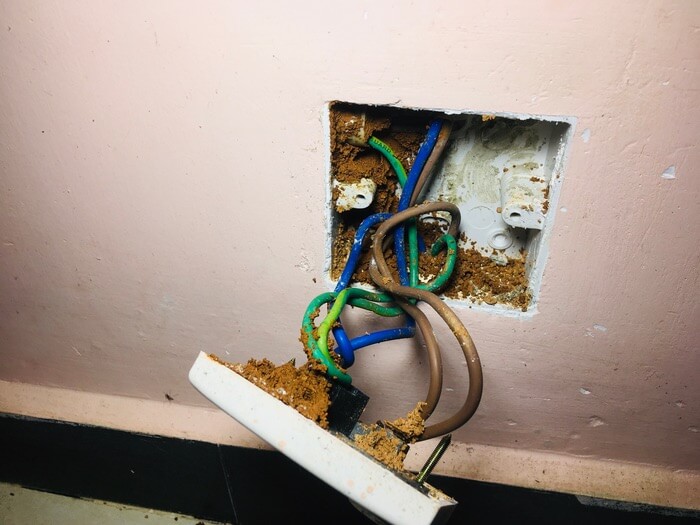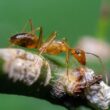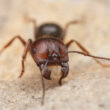Seeing ants coming out of an electrical outlet is creepy, gross, and concerning. You would expect to see these insects in the yard or kitchen, but wall sockets are another thing!
This guide will teach you how to get rid of ants in electrical outlets and prevent them from coming back.
Table of contents
Why Are Ants Coming Out Of Your Electrical Outlet?
It sounds like the stuff of nightmares, but seeing ants coming out of your electrical outlets is pretty common.
These insects don’t need a ton of room to navigate your home or get behind walls. All it takes is a tiny crack or void. Once one ant gets in, more are likely to follow!
You see, ants produce pheromone trails when they find suitable living conditions or food. The trail acts as an invisible tie between the scout ant and the rest of the colony. Other workers can use it to get into your outlets just like the first one!
- Kills common household ants including acrobat, crazy, ghost, little black, odorous house, pavement, and other sweet-eating ants
- As worker ants discover the bait, they share it with the rest of the colony to eliminate them all
- You should see a significant decrease in the number of ants visiting the bait stations within just a few days
- Place stations near areas where you’ve seen ant activity
So, why do they go there in the first place? Well, these bugs are attracted to dark, tight, and warm spaces (among other things). Outlet receptacles, switch boxes, circuit breakers, and other electrical components easily fit the bill.
Quick Tip: Chances are, the ants in your electrical outlets went into your home searching for something else. They probably came in through the foundation, cracks around the door frame, or voids in the window. Once they found some food, they likely explored further and ended up in your outlets.
The most common species to invade electrical installations are tawny, fire, Asian, and kamikaze ants. However, any household species could end up in those components behind your walls.
With smaller infestations, you might see a stray ant creep its way outside of the outlet from time to time. But with more extensive issues, you might actually be able to hear the ants in your walls!
The Importance Of Getting Them Out
Getting rid of ants in electrical outlets isn’t just a matter of comfort. Ants can do some severe damage to your home!
Believe it or not, ants are fully capable of chewing through electrical wires. Sure, the lone ants that attempt to eat their way through live wires usually die of electrical shock. But that’s not going to stop other ants from trying the same thing.
Remember that pheromone trail we mentioned earlier? Well, ants produce another pheromone signal whenever they’re in danger. It’s a unique alert scent that calls in reinforcements.

Before you know it, you may end up with a massive colony of ants attempting the same suicide mission as the first one! While one stray ant chewing through a wire isn’t a huge cause for concern, a large group of them is. They can eat through the protective sheathing of live cables, expose metal, and cause all kinds of issues.
Not only that, but you’ll end up with a pile of dead ants in a super vulnerable place. That mass of ant carcasses can short circuit the outlet and potentially cause a fire. It’s a potential fire risk that you don’t want to leave up to fate (it’s rare, but it’s possible).
The issues don’t stop there.
What if the ants decide to set up shop behind your walls and near electrical installations? When this happens, a flurry of insects will move in. They’ll bring in soil and moisture from outside to build their nest and start building the population.
We all know that moisture and electricity don’t mix! The nest-building process could increase your risks for shorts and long-term damage.
On top of all of that, the ant population can spread to other areas of your home. The last thing you want to do is give ants any opportunity to nest. Once they do, you’re just asking for trouble.
Even if you attempt to get rid of all the ants in the electrical outlets, where are the existing ants going to flee? They’ll just end up moving to other rooms and causing trouble there. It’s an endless cycle that can end up costing you thousands of dollars in repairs. That’s not even including the ramifications of electrical shorts and fires.
As you can see, you should never ignore ants in your wall sockets!
How To Get Rid Of Ants In An Electrical Outlet
There are several things you can do to get rid of ants in an electrical outlet. But before we get into them, it’s essential to understand that there are genuine risks here. Your home’s electrical system is not something you should mess with if you don’t have basic safety knowledge.
If you’re even remotely unsure about operating the breaker panel or how to turn off the main switches, do not attempt a DIY method. Call a professional ant exterminator or electrician instead. Messing with live wires could lead to even more damage or even personal electrocution!
Think you’re ready to tackle this ant problem on your own? Here are some tried and true methods to get rid of the ants that are coming from your outlet once and for all.
1. Use Insecticide Sprays
Here’s the go-to option for most people. Insecticide products are a dime a dozen these days. Visit any big box store, and you can easily find one that’s formulated for ants.
Sprays come in pre-mixed formulas and concentrated liquids. Both options will work well.
Before you apply the spray, turn off the power at the main breaker. Don’t forget to do this! While you can do your best to avoid the wires, sprayers tend to be a little unpredictable.
It’s better to be on the safe side and cut off power to the out altogether. Once that’s done, you’re free to work safely.
In order to get rid of the ants in your electrical outlet, spray the solution around the entire system while avoiding the wires. If you’re having a hard time accessing where the ants are, you could remove the wall plate. Usually, that only requires a simple flathead screwdriver.
Once again, exercise caution here and double-check to make sure that the power is off. If you’re not comfortable, call an electrician for assistance!
The insecticide will kill ants seconds after you spray them. There’s a good chance that most of the ants will flee the moment you press the spray trigger. Try to get as many as possible.
Quick Tip: The residual spray will do a lot to prevent surviving ants from coming back. You can also repeat the process in the coming days to kill any stragglers.
2. Set Up Ant Traps
Insecticides only kill ants that you can see. There could be much more hiding behind your walls or deeper in the electrical socket. If you suspect that’s the case, ant traps might be a better option for you.
- Kills common household ants including acrobat, crazy, ghost, little black, odorous house, pavement, and other sweet-eating ants
- As worker ants discover the bait, they share it with the rest of the colony to eliminate them all
- You should see a significant decrease in the number of ants visiting the bait stations within just a few days
- Place stations near areas where you’ve seen ant activity
Ant traps use poisons that attack the nervous system and digestive tract. But the kicker here is that they take several hours to work. The poisons are cleverly disguised as food that the ants take back to the nest. This is actually one of the most common ways that homeowners kill ants with borax.
By the time the poison starts killing off ants, it’s already spread throughout the colony. Hopefully, it reaches the queen to end the nest once and for all!
Commercial traps are just as accessible as insecticide sprays. They’re compact and easy to work with. Usually, there’s no need to mix any chemicals or touch any ingredients.
The most important thing to think about when selecting traps is to choose one with the right bait food. Some ants are attracted to sweets. Others might prefer proteins and grease (which makes getting rid of grease ants difficult).
Quick Tip: Pay close attention to the species of ant that’s coming out of your electrical outlet and choose accordingly. It also pays to get a few different forms to ensure that you attract as many ants as possible.
Once you have everything ready, set several traps around the affected outlet. You can also put them along known scent trails.
Give the traps a few days to work their magic. It shouldn’t take long for you to notice a significant decrease in the number of ants in the outlet.
3. Eliminate Trails
Here’s a trick that many homeowners don’t even consider. As we talked about earlier, ants rely on scent trails to navigate your home. That means there’s nothing stopping more ants from using those trails, even after you’ve gotten rid of the ants in your electrical outlet.
If you want to make sure that ants can’t find their way back, you have to eliminate those scent trails!
There are a couple of ways to do this:
- You can use the same insecticide sprays you used to kill the ants in the first place.
- You could try a white vinegar or bleach solution.
Vinegar is the safer and gentler choice, but diluted bleach will do well if you’re not worried about inhalation or damage.
Whatever you use, spray it on known scent trails. There’s no way to see routes that ants previously used with your eyes. So, you’ll have to rely on previous observations.
Quick Tip: Before you kill the ants, make a note of how they traveled. Find the paths they used to enter your outlet. They could be on the floor leading up to the outlet, on your home’s exterior, and everywhere in between. Then, use the spray of your choice to eliminate the scent and keep other ants out.
4. Use Peppermint & Cinnamon
Prefer a more natural way to get rid of ants in your electrical outlets? Try cinnamon and peppermint.
Ants hate intense aromas from herbs and spices. The scents throw off their sense of direction and cause confusion. So, most tend to avoid the smells as much as possible.
You can use that fact to your advantage. Strong odors aren’t going to kill the insects, but they can make your outlet and any nearby areas unlivable.
Quick Tip: Like before, turn off the power to the affected outlet before you apply any liquids.
Powdered cinnamon is excellent for disrupting nests and tunnels. Just sprinkle it over those entry points and trails.
To use peppermint, turn to essential oils. Mix several drops of the oil with clean water. Then, use it like you would an insecticide. You can also just buy a spray like this one.
Spray it throughout the outlet and avoid the wires. The ants should flee and never return! Best of all, the aromas linger to prevent future issues.
Ways To Prevent Them From Getting Into Your Outlets
Even after you successfully exterminate the ants, your work is not done. Ants are cunning insects that can easily return to wreak havoc once again.
To ensure that you never have to deal with this issue again, you have to adopt some preventative measures.
Keep Your Home Clean
The first step in preventing any more ants from coming out of your electrical outlet is keeping your home clean. Ants always have a reason for entering your domain. In the vast majority of cases, it’s because they find food.
Everything from stray crumbs to that plate of leftovers you leave sitting on your countertop can draw them in. The same goes for a smelly trash can and dirty dishes.
Take the time to wipe up every spill and make your home spotless. It’s a good idea to pay extra special attention to the kitchen, as that’s where most ant-attracting foods are. In fact, getting rid of ants in the kitchen sink is something that many homeowners need to do.
But don’t forget the other rooms in your house too! We’re all guilty of eating on the couch or in the bedroom, so there’s a good chance that crumbs and morsels are everywhere!
Quick Tip: Stick to a cleaning schedule and make your house pristine. A little effort now will save you a massive headache in the future.
Seal All Potential Entry Points
Take some time to seal up all access points that ants can use to get inside wall sockets. Look around door frames, windows, and foundations.
If necessary, hire a home inspector or exterminator! They know where to look and will help you identify vulnerable areas.
Seal those voids with caulk to stop ants in their tracks.
While you’re at it, call an electrician to seal individual electrical components. Sealing and insulating outlets, breaker boxes, and more will decrease the chances of insect invasions. It’s a good idea to use things like Teflon and rubber electrical tape to address vulnerable elements, too.
Sealing outlets and entry points is a time-consuming process, but it makes all the difference.
Apply Repellents Regularly
Finally, take advantage of repellent products.
Those who prefer natural and eco-friendly methods of pest control can use the peppermint spray we went over earlier. Apply it regularly to make the aroma ever-present!
Alternatively, you can get help from a pest control expert. Professionals can apply chemical deterrents inside your home and around the perimeter. Pesticide crystals are particularly effective around foundations.
Repellents create an invisible barrier around your home to keep it ant-free. If they can’t enter your home, you won’t find any coming out of your outlets!
Conclusion
Getting rid of ants that have been coming out of your electrical outlet can be frustrating, but it’s not impossible. All it takes is a little knowledge and persistence to reclaim your home!
If you have a particularly difficult infestation in your wall sockets that you can’t handle on your own, we’re more than happy to help or connect you with a pest control professional. Just ask!



